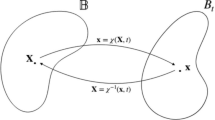Abstract
Kinetic and potential energy are included in the first law of thermodynamics in quite a contradictory way. Whereas in thermodynamics the total energy is understood as the sum of internal, kinetic and potential energy, the total energy in continuum mechanics incorporates only internal and kinetic energy, the potential energy being part of the work. The Gibbs ' fundamental equation is also occasionally extendend to contain a term for the potential energy. Some serious contradictions may result from this. As is first shown, kinetic and potential energy do not have any influence on the internal energy as long as relativistic effects are excluded. The Gibbs' fundamental equation therefore describes exchange processes between the “internal variables„ of a system and its surroundings. Proceeding from this result one obtains a general definition of heat in open systems, including electromagnetic reactions, surfaceeffects and variable mole numbers. Exchange processes between the “external variables„ of a system and its surroundings and hence also the influence of kinetic and potential energy are described by another independent equation, i.e. the energy equation of mechanics. Addition of both equations leads to the heat definition which is usually but under some further neglects given in textbooks. This definition has considerable disadvantages compared to the one derived before. In particular it is no longer possible to realize how mechanical and thermal energy are transformed into each other, which may give rise to errors.
Zusammenfassung
Kinetische und potentielle Energie werden in der Literatur in unterschiedlicher Weise in den ersten Hauptsatz einbezogen. WÄhrend man in der Thermodynamik die Gesamtenergie als Summe aus innerer, kinetischer und potentieller Energie auffa\t, wird in der Kontinuumsmechanik nur die kinetische Energie zur inneren addiert, die potentielle hingegen zur Arbeit gezÄhlt. Auch die Gibbssche Fundamentalgleichung wird gelegentlich in unterschiedlicher Weise um einen Term für die potentielle Energie erweitert. Dadurch können widersprüchliche Ergebnisse entstehen. Es wird zunÄchst dargelegt, da\ kinetische und potentielle Energie ohne Einflu\ auf die innere Energie sind, solange man relativistische Effekte ausschlie\t. Die Gibbssche Fundamentalgleichung beschreibt daher Wechselwirkungen zwischen den “inneren Variablen„ eines Systems und seiner Umgebung. Ausgehend davon gewinnt man eine allgemeine Definition der WÄrme für offene Systeme, unter Einschlu\ elektromagnetischer Effekte, chemischer Reaktionen, OberflÄchenerscheinungen und verÄnderlicher Teilchenzahlen. Die Wechselwirkungen zwischen den “Äu\eren Variablen„ eines Systems und seiner Umgebung und damit der Einflu\ von kinetischer und potentieller Energie werden durch den von dieser Definition unabhÄngigen Energiesatz der Mechanik erfa\t. Addition beider SÄtze führt zu der vielfach in Lehrbüchern unter weiteren Vereinfachungen angegebenen WÄrmedefinition. Sie besitzt erhebliche Nachteile gegenüber der zuvor mitgeteilten Definition, die im einzelnen diskutiert werden. Insbesondere kann man nicht mehr erkennen, wie mechanische und thermische Energie ineinander verwandelt werden, was Anla\ zu Fehlschlüssen sein kann.
Similar content being viewed by others
Abbreviations
- c:
-
velocity of light
- E:
-
energy
- E *j :
-
electrostatic field strength
- Ekin :
-
kinetic energy
- ekin :
-
specific kinetic energy
- Epot :
-
potential energy
- epot :
-
specific potential energy
- F:
-
force
- f:
-
specific force
- F′:
-
conservative force
- F″:
-
nonconservative force
- g:
-
gravity
- H:
-
enthalpy
- h:
-
specific enthalpy
- Jk,j :
-
diffusion flux density Jk,j=ρk (wk,j−wj)
- L:
-
work
- L* :
-
total work: L*=L+∫ Fj ″dxj
- M:
-
molar mass
- m:
-
mass
- n:
-
mole number
- P:
-
momentum P=mw
- p:
-
pressure
- Q:
-
heat
- q:
-
heat flux density
- r:
-
radius
- S:
-
entropy
- t:
-
time
- U:
-
internal energy
- u:
-
specific internal energy
- V:
-
volume
- w:
-
velocity
- Xk :
-
work coordinate
- xk :
-
work coefficient
- z:
-
height, distance
- Ø:
-
potential
- ϕ:
-
specific potential
- Μ:
-
chemical potential
- Ω:
-
angular velocity
- ρ:
-
density
- Τij :
-
shear stress tensor in carthesian coordinate sy stem
- a:
-
exterior, outside
- i:
-
interior, inside
- j in:
-
direction j of a carthesian coordinate system
- k:
-
component k
- 1:
-
component 1
- k,j:
-
component k in direction j
- diss:
-
dissipative
References
Caratheodory, C.: Untersuchungen über die Grundlagen der Thermodynamik. Math. Ann. 67 (1909) 355/386
Born, M.: Kritische Betrachtungen zur traditionellen Darstellung der Thermodynamik. Phys. Z. 22 (1921) 218/224, 249/254, 282/286
Tribus, M.: Genralizing the meaning of heat. Int. J. Heat Mass Transf. 11 (1968) 9/14
Dzung, L.S.: Note on the meaning of “heat„. Int. J. Heat Mass Transf. 11 (1968) 1575/76
Truesdell, C.: Tational thermodynamics. New York: McGraw Hill (1969)
Haase, R.: Thermodynamik der irreversiblen Prozesse. Darmstadt: Dr. Dietrich Steinkopff (1963)
Hatsopoulos, G.N.; Keenan, J.H.: Principles of general thermodynamics. New York/London/Sydney: John Wiley sons Inc. (1965)
Baehr, H.D.: Thermodynamik. Berlin/Heidelberg/ New York: Springer 3. Aufl. (1973)
Meixner, J.: Thermodynamik der irreversiblen Prozesse, in Handbuch der Physik Bd. III, 2. Berlin/ Göttingen/Heidelberg: Springer (1959)
Bird, R.B.; Steward, W.E.; Lightfoot, E.N.: Transport phenomena. New York/London/Sydney: John Wiley sons Inc. (1960)
Vincenti, W.G.; Krüger jr, Ch.H.: Introduction to physical gas dynamics. New York/Sydney: John Wiley sons Inc. (1965)
Zierep, J.: Vorlesungen über theoretische Gasdynamik. Karlsruhe: G. Braun (1962)
The scientific papers of Gibbs, J.W.: vol. 1, Thermodynamics. New York: Dover Publ. Inc. (1961)
Pitzer, K.S.; Brewer, L.: Thermodynamics (Rev. of Lewis and Randall). New York/London/Toronto: Bac Graw Hill (1961)
Guggenheim, E.A.: Thermodynamics. North Holland Publ. Comp. Amsterdamm (1967)
Martin, J.J.: The symmetric fundamental property relation of thermodynamics. Chem. Ing. Techn. 44 (1972), no. 5, 249/257
Falk, G.: Theoretische Physik auf der Grundlage einer allgemeinen Dynamik. Bd. II, Berlin/Heidelberg/New York: Springer (1968)
Prigogine, I.: Introduction to thermodynamics of irreversible processes. New York/London/Sydney: Intersc. Publ. (1965)
Author information
Authors and Affiliations
Rights and permissions
About this article
Cite this article
Stephan, K. Kinetic and potential energy in the first law of thermodynamics. Warme- und Stoffubertragung 8, 1–10 (1975). https://doi.org/10.1007/BF02568592
Received:
Issue Date:
DOI: https://doi.org/10.1007/BF02568592




